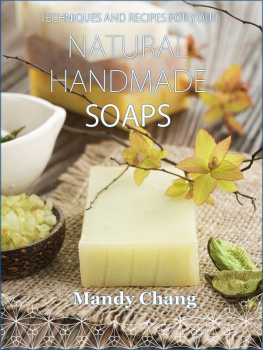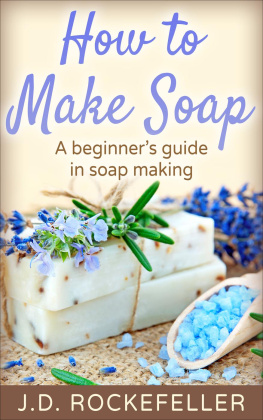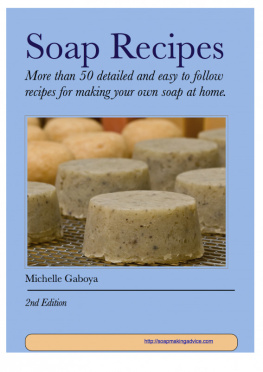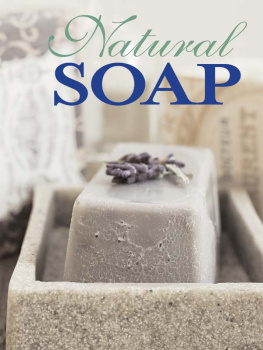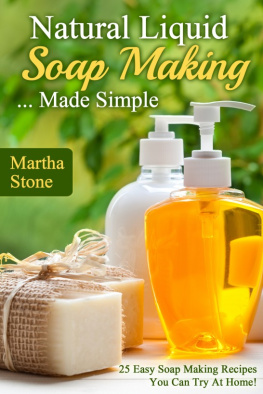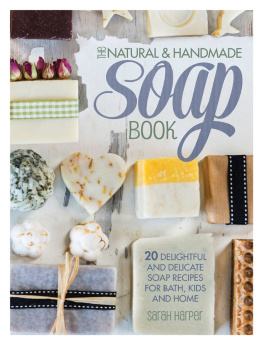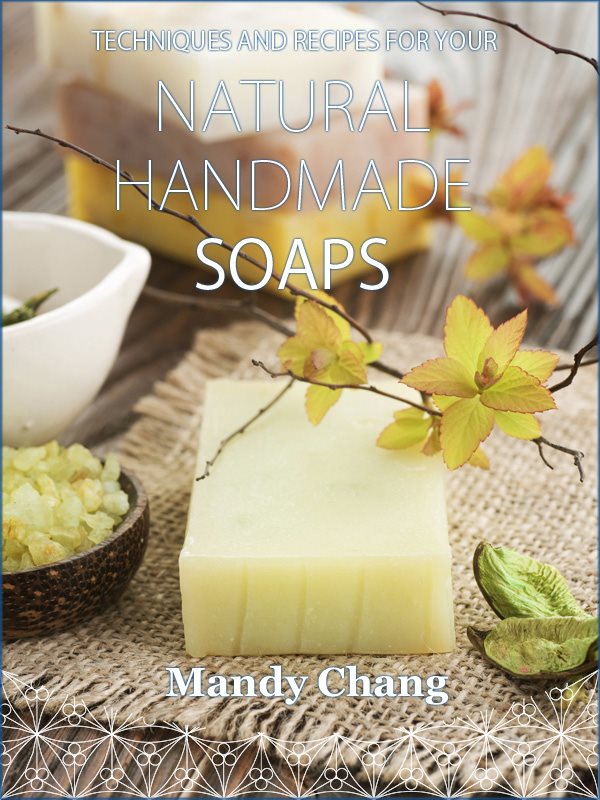Contents
Introduction
M AKING your own soaps using natural ingredients at home is not a difficult task as many people think. While preparing the soap base may require some time before being perfect, natural ingredients to be added to your own soap can be easily found in the enarby store if not in the garden.
This book is meant to offer you a detailed escription of what homemade soap making entails. From the tools needed to the techniques most in use these days, it will help you to get started in preparing soaps that can then be tailored to specific uses depending upon your needs. Herbs will help you in the process, being ingredients that since ancient times have played an important role when it comes with treating various health conditions. Among the herbs that can make your bath more stimulating and tranquilizing are the bergamot, passion flower, sandalwood, marjoram and lavender. I will discuss about those while introducing their essential oils, one of the main ingredient in soap making.
In these days more and more people are shifting from industrially made soaps to hand made ones with the result that herbal (and fruit) soaps are now giving synthetic soaps a tough competition. This change in peoples habits is given by the fact that the chemical additions made in the synthetic soaps could create several side effects on the skin. As amatter of fact, some of these soaps are made with chemicals proved to be harsh on the skin, an element that may evetually increase the sensitivity of your skin if not even make it more prone to allergies.
Using herbal soaps, instead, has been proved to be safe enough for the skin if not even creating positive changes to its appearance and qualities given their content in natural ingredients.
Chapter 1
History of soap making
I T is believed that soap making started as early as 2800 B.C. Archeologists in Mesopotamia came across the first findings about soap when they discovered a cylinder made of clay covered with a material similar to soap. In their reconstruction of the ancient technique of making soaps, they described this discovery as a method involving boiliing fats together with ashes.
Other important sources in the soap making history are found in different medical texts written on papyrus. These books contain information about different types of methods used to make soap in Egypt and other Mediterranean regions. One of these methods was to mix animal fats as well as vegetable oils with alkaline salts. The result was then used for bathing as well as treating skin problems.
Even the Holy Bible itself tells us about how the Israelites combining ashes with vegetable oils were able to make a substance that looked like a hair gel. This substance was used then as soap for bathing and washing.
Later, during the second century A.D., Alexandria, a popular physician, started to commercialize the use of soap by explaining people how to use it to treat skin conditions as well as for cleaning purposes.
It is also believed that during this time, people in Rome as well as in Greece started to sistematically use soap to wash their bodies. Before starting using soaps, in fact, Greeks and Romans were used to rub oil all over their bodies, using then pumice stones to remove it.
German and Gauls, instead, after learning the technique from the Mediterranean civilizations, started to combine animal fats and ashes with herbs in the mixture.
Having taken the basic skills from soap making from Eastern civilizations such as Indians and Chinese, the Arabs were seen by Europeans among the wisest ancient people in making soaps. They started to use aromatic oils such as thyme as well as other aromatic vegetable oils to produce both hard bars and liquid soaps with beautiful fragrances.
The Europeans mostly began to use soaps on a broader base for personal care and hygiene after the Reinaissance [1]. They adopted the idea of soap making from the earlier civilizations and collected the first lye by leaving water to flow through the wood ashes. The solution formed was then mixed with animal fats or vegetable oils to form soap.
The basic soap making process is still similar in its main parts today to this latted technique used and improved in time by Europeans.
Chapter 2
Soap making tools and ingredients
I N this chapter I included the basic tools you will need to start to make your soaps at the comfort of your home. While different soap making processes will require different equipment, I will focus only on the cold process since this is a process requiring the highest number of tools when compared with others.
Measuring tools
Knowing the exact amount of ingredients to be used when making soap is curcial if you want to obtain the desired results. The basic measuring tools you will need will include one weighing scale, a set of measuring spoons, measuring cups and a cooking thermometer.
Cookware
Find a an old saucepan you will use specifically for soap making from now on. Other cookware includes a stick blender for stirring, knives for cutting and slicing soaps, wooden spoons as well as bowls.
Molds
As you may imagine, molds plays an important role in soap making process. Soap making molds are available in various sizes and shapes and what is good about them is that depending upon material they are made of (e.g. wood, silicon) permit you to reuse them several times.
Standard bar soap molds are usually available in rectangular shape with either round or squared edges. Because of their shape, with this type of mold the resulting soap will be easy to handle [2].
Other molds come in various forms ranging from hearts, flowers, butterflies to fun shapes such as crayons, frogs, bad bears. These molds allow you to design soaps for special occasions such as Halloween and Christmas.
Nowadays there are molds that enable you to pour in several batches of soap. These are more suitable when you want to produce several soaps since they also make the process of cutting the soap into desired sizes easier than normal molds.
Melt and pour soap bases
Soap bases are the foundation to be used to start to build your soap. Ultra white soap base is among the top rated soap making base in the market today. It is snow white in color and forms an excellent lather.
While suspension soap bases are suitable for suspending generic herbs and seeds, other bases are meant to be used for specific ingredients such as aloe vera and olive oil, honey, oatmeal and even goat milk.
Lye and distilled water
Distilled water and lye form the most essential ingredient in soap making. The lye solution is sodium hydroxide mixed with distilled water. To make soap, this solution is mixed with essential oils, leading to a chemical reaction usually known as saponification. I will discuss about this process in the next chapter of the book. As for now, it is important for you to understand that it is relatively difficult and sometimes boring to correctly calculate the amount of sodium hydroxide required to make soap. However, nowadays there are several tools that can be used for free online (e.g. http://www.soapcalc.net/calc/SoapCalcWP.asp with a very simple step-by-step process to follow to input the different ingredients).
In making soap, distilled water is another crucial ingredient even if, sometimes, you can use alternatives such as rice milk, almond milk, butter milk, goats milk, coconut milk, and, of course, cow milk. You can also use other alternatives such as herbal teas, regular tea, coffee as well as vegetable and fruit juices.
Safety equipment
Lye is an acidic solution that, when in contact with the skin, can cause several degrees of irritations. To avoid any accidents of this sort, you will need to wear rubber boots, thick trousers, long rubber gloves, goggles, and, in case you are making several soaps, a raincoat.

